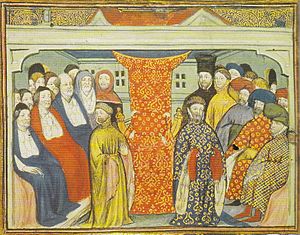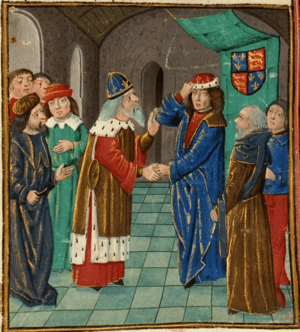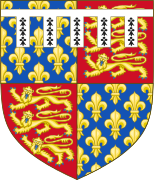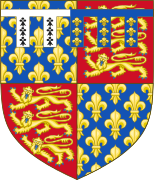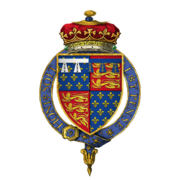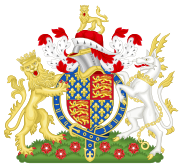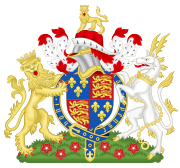Henry IV of England facts for kids
Quick facts for kids Henry IV |
|
|---|---|
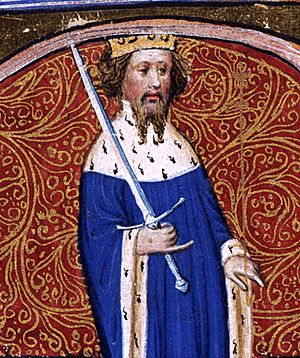
Illuminated picture, c. 1402
|
|
| King of England (more...) | |
| Reign | 30 September 1399 – 20 March 1413 |
| Coronation | 13 October 1399 |
| Predecessor | Richard II |
| Successor | Henry V |
| Born | c. April 1367 Bolingbroke Castle, Lincolnshire, England |
| Died | 20 March 1413 (aged 45) Jerusalem Chamber, Westminster, England |
| Burial | Canterbury Cathedral, Kent, England |
| Spouse |
|
| Issue more... |
|
| House | Lancaster (Plantagenet) |
| Father | John of Gaunt |
| Mother | Blanche of Lancaster |
| Signature |  |
Henry IV (born around April 1367 – died 20 March 1413), also known as Henry Bolingbroke, was the King of England from 1399 to 1413. He was the first English king in over 300 years whose main language was English, not French. His grandfather, King Edward III, had claimed the French throne, and Henry continued this claim.
Henry was the son of John of Gaunt, who was the Duke of Lancaster and a powerful figure in England. John of Gaunt was also the son of King Edward III. Henry was involved in a rebellion against his cousin, King Richard II, in 1388, which led to Henry being sent away from England.
When Henry's father died in 1399, King Richard II stopped Henry from inheriting his father's lands. That same year, Henry gathered supporters, overthrew Richard II, and took the throne for himself. These actions later played a part in the Wars of the Roses, a series of wars fought over who should be king.
As king, Henry faced many challenges. There were rebellions, especially from Owain Glyndŵr, who said he was the ruler of Wales, and from the English knight Henry Percy (Hotspur). Hotspur was killed in the Battle of Shrewsbury in 1403. Henry IV became very ill later in his reign. His oldest son, Henry of Monmouth, started to take over the government in 1410. Henry IV died in 1413, and his son became King Henry V.
Contents
Early Life and Family
Henry was born at Bolingbroke Castle in Lincolnshire, England. This is why he was sometimes called "Henry Bolingbroke." His parents were John of Gaunt and Blanche of Lancaster. John of Gaunt was the third son of King Edward III. Blanche was the daughter of a very rich and important nobleman, Henry, Duke of Lancaster.
Henry's father, John of Gaunt, had a lot of power during the reign of his nephew, King Richard II. Henry had two older sisters: Philippa, who became Queen of Portugal, and Elizabeth. He also had a younger half-sister, Katherine, who became Queen of Castile. Katherine was the daughter of his father's second wife.
Henry also had four half-siblings from his father's relationship with Katherine Swynford. Katherine was first his sisters' governess, then his father's long-time partner, and later his father's third wife. These children were given the last name Beaufort. Henry got along well with his stepmother, Katherine Swynford.
Henry's Relationship with King Richard II
Henry's relationship with King Richard II was not always easy. They were first cousins and played together as children. In 1377, they both became knights of the Order of the Garter. However, Henry joined a group of nobles called the Lords Appellants who rebelled against the king in 1387.
After Richard regained power, he did not punish Henry. Instead, Richard gave Henry a higher title, changing him from Earl of Derby to Duke of Hereford.
In 1392–93, Henry went on a special trip to Jerusalem. He made promises at important holy sites there. He later vowed to lead a crusade to "free Jerusalem," but he died before he could do this.
Their relationship faced another problem in 1398. Henry told the king about a comment made by Thomas de Mowbray, 1st Duke of Norfolk, which was seen as treason. The two dukes planned to fight a duel to settle the matter. But before the duel, King Richard decided to send Henry away from England. Mowbray was also sent away for life.
Henry's father, John of Gaunt, died in February 1399. Without a good reason, King Richard cancelled the legal papers that would have allowed Henry to inherit his father's lands. This meant Henry would have to ask Richard for his own inheritance.
Becoming King
After some thought, Henry met with Thomas Arundel, who used to be the archbishop of Canterbury. Arundel had lost his job because he was involved with the Lords Appellant. Henry and Arundel returned to England while King Richard was away fighting in Ireland.
With Arundel's help, Henry started a military campaign. He took land from those who were against him. Henry first said he only wanted to get back his rights as Duke of Lancaster. But he quickly gained enough power and support to declare himself King Henry IV. He put King Richard in prison, where Richard later died. Henry also bypassed Richard's young heir, Edmund de Mortimer.
Henry's coronation took place on 13 October 1399 at Westminster Abbey. It may have been the first time since the Norman Conquest that the new king spoke to the people in English.
Henry's Time as King
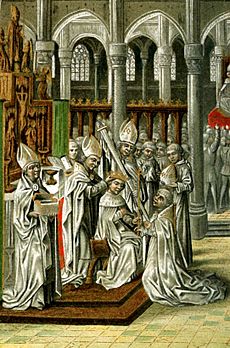
Henry made a law that the Duchy of Lancaster would always belong to the king. He often talked with Parliament, but they sometimes disagreed, especially about church matters. Henry supported laws against certain religious groups, which he believed were causing problems.
One of Henry's first big challenges was what to do with the former king, Richard. After a plot to kill Henry was stopped in January 1400, Richard died in prison at age 33. Historians still wonder exactly how he died.
After Richard's death, his body was shown in public. This was to prove to his supporters that he was truly dead and had not been killed violently. But rumors still spread for years that he was alive. Henry had Richard buried quietly at a priory. Later, King Henry V moved Richard's body to the tomb Richard had built for himself in Westminster Abbey.
Rebellions Against Henry IV
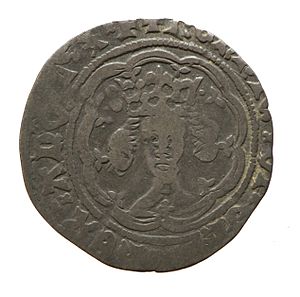
Henry spent much of his time as king defending himself from plots and rebellions. Rebellions continued for the first 10 years of his rule. These included the revolt of Owain Glyndŵr, who declared himself Prince of Wales in 1400. There were also rebellions led by Henry Percy, 1st Earl of Northumberland.
The first Percy rebellion ended at the Battle of Shrewsbury in 1403. The earl's son, Henry, a famous soldier known as "Hotspur," was killed in this battle. In the same battle, Henry IV's oldest son, Henry of Monmouth (who would become King Henry V), was hurt by an arrow in his face. Even with this injury, the king's side won the battle.
In the last year of Henry's reign, the rebellions grew stronger. Some people spread rumors that King Richard was still alive in Scotland. An impostor who looked like Richard was found. People in London were encouraged to rebel, but the rebellion did not succeed.
Foreign Relations During Henry's Reign
Early in his reign, Henry welcomed Manuel II Palaiologos, the only Byzantine emperor to ever visit England. He stayed from December 1400 to February 1401 at Eltham Palace. Henry also sent money with Manuel to help him fight against the Ottoman Empire.
In 1406, English pirates captured the future James I of Scotland. He was only eleven years old and was sailing to France. James was given to Henry IV and remained a prisoner for the rest of Henry's reign.
Henry's Final Illness and Death
The last years of Henry's reign were marked by serious health problems. He had a skin disease and suffered from severe attacks of another illness. These attacks happened in 1405, 1406, 1408, and 1412. His final, fatal attack was in March 1413. Doctors today still discuss what his illnesses might have been. Some people in the Middle Ages believed his skin disease was a punishment for his actions against Richard le Scrope, the Archbishop of York.
It was said that Henry would die in Jerusalem. He thought this meant he would die on a crusade. But he actually died in the Jerusalem Chamber at Westminster Abbey on 20 March 1413. This room was part of the abbot's house.
Henry's Burial
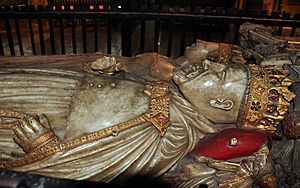
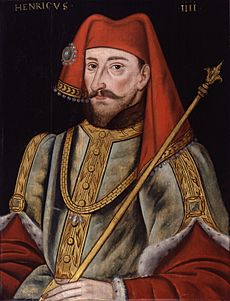
Unlike many kings before him, Henry and his second wife, Joan of Navarre, Queen of England, were not buried at Westminster Abbey. They were buried at Canterbury Cathedral, next to the shrine of St Thomas Becket. Thomas Becket was a very popular saint at the time.
Henry seemed to have a special connection to Becket. At his coronation, he was anointed with holy oil that was said to have been given to Becket by the Virgin Mary. This oil was kept in a special eagle-shaped container. Henry's choice to be buried near Becket likely helped make his rule seem more legitimate after he took the throne from Richard II.
His tomb shows this connection. A wooden panel on his tomb has a painting of Becket's death. The canopy above the tomb is painted with Henry's personal motto, 'Soverayne', and golden eagles. These eagle symbols point to his coronation oil and his link to Becket. After Henry's death, a grand tomb was built for him and Queen Joan. On top of the tomb are detailed statues of Henry and Joan, wearing their crowns and royal robes.
Titles and Symbols
Titles Held by Henry IV
- Earl of Derby (1377–1397)
- Earl of Northampton and Hereford (1384–1399)
- Duke of Hereford (1397–1399)
- Duke of Lancaster (1399)
- King of England and Lord of Ireland (1399–1413)
Henry's Coat of Arms
Before his father died in 1399, Henry used the royal coat of arms with a special mark to show he was not the king. After his father's death, this mark changed. When he became king, Henry updated the royal coat of arms to match changes in the French royal arms, from many fleur-de-lys to just three.
-
Henry's coat of arms as 3rd Earl of Derby, KG
Family Tree
| English royal families in the Wars of the Roses | |||||||||||||||||||||||||||||||||||||||||||||||||||||||||||||||||||||||||||||||||||||||||||||||||||||||||||||||||||||||||||||||||||||||||||||||||||||||||||||||||||||||||||||||||||||||||||||||||||||||||||||||||||||||||||||||||||||||||||||||||||||||||||||||||||||||||||||||||||||||||||||||||||||||||||||||||||||||||||||||||||||||||||||||||||||||||||||||||||||||||||||||||||||||||||||||||||||||||||||||||||||||||||||||||||||||||||||||||||||||||||||||||||||||||||||||||||||||||||||||||||||||||||||||||||||||||||||||||||||||||||||||||||||||||||||||||||||||||||||||||||||||||||||||||||||||||||||||||||||||||||||||||||||||||||||||||||||||||||||||||||||||||||||||||||||||||||||||||||||||||||||||||||||||||||||||||||||||||||||||||||||||||||||||||||||||||||||||||||||||||||||||||||||||||||||||||||||||||||||||||||||||||||||||||||||||||||||||||||||||||||||||||||||||||||||||||||||||||||||||||||||||||||||||||||||||||||||||||||||||||||||||||||||||||||||||||||||||||||||||||||||||||||||||||||||||||||||||||||||||
|---|---|---|---|---|---|---|---|---|---|---|---|---|---|---|---|---|---|---|---|---|---|---|---|---|---|---|---|---|---|---|---|---|---|---|---|---|---|---|---|---|---|---|---|---|---|---|---|---|---|---|---|---|---|---|---|---|---|---|---|---|---|---|---|---|---|---|---|---|---|---|---|---|---|---|---|---|---|---|---|---|---|---|---|---|---|---|---|---|---|---|---|---|---|---|---|---|---|---|---|---|---|---|---|---|---|---|---|---|---|---|---|---|---|---|---|---|---|---|---|---|---|---|---|---|---|---|---|---|---|---|---|---|---|---|---|---|---|---|---|---|---|---|---|---|---|---|---|---|---|---|---|---|---|---|---|---|---|---|---|---|---|---|---|---|---|---|---|---|---|---|---|---|---|---|---|---|---|---|---|---|---|---|---|---|---|---|---|---|---|---|---|---|---|---|---|---|---|---|---|---|---|---|---|---|---|---|---|---|---|---|---|---|---|---|---|---|---|---|---|---|---|---|---|---|---|---|---|---|---|---|---|---|---|---|---|---|---|---|---|---|---|---|---|---|---|---|---|---|---|---|---|---|---|---|---|---|---|---|---|---|---|---|---|---|---|---|---|---|---|---|---|---|---|---|---|---|---|---|---|---|---|---|---|---|---|---|---|---|---|---|---|---|---|---|---|---|---|---|---|---|---|---|---|---|---|---|---|---|---|---|---|---|---|---|---|---|---|---|---|---|---|---|---|---|---|---|---|---|---|---|---|---|---|---|---|---|---|---|---|---|---|---|---|---|---|---|---|---|---|---|---|---|---|---|---|---|---|---|---|---|---|---|---|---|---|---|---|---|---|---|---|---|---|---|---|---|---|---|---|---|---|---|---|---|---|---|---|---|---|---|---|---|---|---|---|---|---|---|---|---|---|---|---|---|---|---|---|---|---|---|---|---|---|---|---|---|---|---|---|---|---|---|---|---|---|---|---|---|---|---|---|---|---|---|---|---|---|---|---|---|---|---|---|---|---|---|---|---|---|---|---|---|---|---|---|---|---|---|---|---|---|---|---|---|---|---|---|---|---|---|---|---|---|---|---|---|---|---|---|---|---|---|---|---|---|---|---|---|---|---|---|---|---|---|---|---|---|---|---|---|---|---|---|---|---|---|---|---|---|---|---|---|---|---|---|---|---|---|---|---|---|---|---|---|---|---|---|---|---|---|---|---|---|---|---|---|---|---|---|---|---|---|---|---|---|---|---|---|---|---|---|---|---|---|---|---|---|---|---|---|---|---|---|---|---|---|---|---|---|---|---|---|---|---|---|---|---|---|---|---|---|---|---|---|---|---|---|---|---|---|---|---|---|---|---|---|---|---|---|---|---|---|---|---|---|---|---|---|---|---|---|---|---|---|---|---|---|---|---|---|---|---|---|---|---|---|---|---|---|---|---|---|---|---|---|---|---|---|---|---|---|---|---|---|---|---|---|---|---|---|---|---|---|---|---|---|---|---|---|---|---|---|---|---|---|---|---|---|---|---|---|---|---|---|---|---|---|---|---|---|---|---|---|---|---|---|---|---|---|---|---|---|---|---|---|---|---|---|---|---|---|---|---|---|---|---|---|---|---|---|---|---|---|---|---|---|---|---|---|---|---|---|---|---|---|---|---|---|---|---|---|---|---|---|---|---|---|---|---|---|---|---|---|---|---|---|---|---|---|---|---|---|---|---|---|---|---|---|---|---|---|---|---|---|---|---|---|---|---|---|---|---|---|---|---|---|---|---|---|---|---|---|---|---|---|---|---|---|---|---|---|---|---|---|---|---|---|---|---|---|---|---|---|---|---|---|---|---|---|---|---|---|---|---|---|---|---|---|---|---|---|---|---|---|---|---|---|---|---|---|---|---|---|---|---|---|---|---|---|---|---|---|---|---|---|---|---|---|---|---|---|---|---|---|---|---|---|---|---|---|---|---|---|---|---|---|---|---|---|---|---|---|---|---|---|---|---|---|---|---|---|---|---|---|---|---|---|---|---|---|---|---|---|---|---|---|---|---|---|---|---|---|---|---|---|---|---|---|---|---|---|---|---|---|---|---|---|---|---|---|---|---|---|---|---|---|---|---|---|---|---|---|---|---|---|---|---|---|---|---|---|---|---|---|---|---|---|---|---|---|---|---|---|---|---|---|---|---|---|---|---|---|---|---|---|---|---|---|---|---|---|---|---|---|---|---|---|---|---|---|---|---|---|---|---|---|---|---|---|---|---|---|---|---|---|---|---|---|---|
|
Individuals with red dashed borders are Lancastrians and blue dotted borders are Yorkists. Some changed sides and are represented with a solid thin purple border. Monarchs have a rounded-corner border.
|
|||||||||||||||||||||||||||||||||||||||||||||||||||||||||||||||||||||||||||||||||||||||||||||||||||||||||||||||||||||||||||||||||||||||||||||||||||||||||||||||||||||||||||||||||||||||||||||||||||||||||||||||||||||||||||||||||||||||||||||||||||||||||||||||||||||||||||||||||||||||||||||||||||||||||||||||||||||||||||||||||||||||||||||||||||||||||||||||||||||||||||||||||||||||||||||||||||||||||||||||||||||||||||||||||||||||||||||||||||||||||||||||||||||||||||||||||||||||||||||||||||||||||||||||||||||||||||||||||||||||||||||||||||||||||||||||||||||||||||||||||||||||||||||||||||||||||||||||||||||||||||||||||||||||||||||||||||||||||||||||||||||||||||||||||||||||||||||||||||||||||||||||||||||||||||||||||||||||||||||||||||||||||||||||||||||||||||||||||||||||||||||||||||||||||||||||||||||||||||||||||||||||||||||||||||||||||||||||||||||||||||||||||||||||||||||||||||||||||||||||||||||||||||||||||||||||||||||||||||||||||||||||||||||||||||||||||||||||||||||||||||||||||||||||||||||||||||||||||||||||
Marriages and Children
First Marriage: Mary de Bohun
Henry's first marriage was to Mary de Bohun (who died in 1394). The exact date and place are not fully known, but her marriage license was bought in June 1380. The wedding is thought to have happened on 5 February 1381, at Mary's family home. There was a rumor that Mary's sister tried to stop the marriage so she could control Mary's inheritance. Mary was then convinced to marry Henry. They had six children:
| Name | Arms | Blazon |
|---|---|---|
| Henry V of England (1386–1422), 1st son |  |
Royal arms of King Henry IV |
| Thomas, Duke of Clarence (1387–1421), 2nd son. He married Margaret Holland, but they had no children. |  |
Royal arms of King Henry IV with a special mark to show difference |
| John, Duke of Bedford (1389–1435), 3rd son. He married twice but had no children. |  |
Royal arms of King Henry IV with a special mark to show difference |
| Humphrey, Duke of Gloucester (1390–1447), 4th son. He married twice but had no children who survived. |  |
Royal arms of King Henry IV with a special mark to show difference |
| Blanche of England (1392–1409). She married Louis III, Elector Palatine in 1402. | ||
| Philippa of England (1394–1430). She married Eric of Pomerania, who was king of Denmark, Norway, and Sweden, in 1406. |
Henry had four sons from his first marriage. This was important because King Richard II had no children.
Mary de Bohun died in 1394. On 7 February 1403, Henry married Joanna, the daughter of Charles II of Navarre. She was the widow of a duke from Brittany and had four daughters and four sons from her first marriage. However, Henry and Joanna did not have any children together.
See also
 In Spanish: Enrique IV de Inglaterra para niños
In Spanish: Enrique IV de Inglaterra para niños
- Cultural depictions of Henry IV of England
- Naish Priory in Somerset contains corbelled heads of Henry IV and Joanna celebrating their marriage, at the manor of Mary de Bohun's late and powerful great-aunt, Margaret de Bohun
- List of earls in the reign of Henry IV of England
- Mouldwarp


